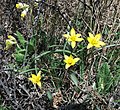
The taxonomy of Tulipa places the genus in the family Liliaceae, and subdivides it as four subgenera, and comprises about 75 species.

The taxonomy of Tulipa places the genus in the family Liliaceae, and subdivides it as four subgenera, and comprises about 75 species.
While tulips were known from at least the 12th century in Persia, and appear in decorative art in Turkey in the 13th century, the first description in European botanical literature, was by Conrad Gesner in his De Hortus Germanica (1561), which he referred to as Tulipa turcarum, and states he saw in a garden in Augsburg in 1559. [1]
The taxonomy of Tulipa has always been complex and difficult for many reasons. Tulipa is a genus of the Liliaceae (lily) family, once one of the largest family of monocots, but which molecular phylogenetics has shown to be a much smaller discrete family with only 15 genera. Within Liliaceae, Tulipa is placed within Lilioideae, one of three subfamilies, with two tribes. Tribe Lilieae includes seven other genera in addition to Tulipa. Some species with a more eastern distribution (China, Korea, Japan) formerly classified as Tulipa are now considered as the separate genus Amana , including Amana edulis (Tulipa edulis). [1] These species are more closely allied to Erythronium , [2] although some authors believe that all three genera of the Tulipeae could be treated as a single genus. [1]
The evolutionary and phylogenetic relationships between the genera currently included in Liliaceae are shown in this Cladogram.
| Cladogram: Phylogeny and biogeography of the genera of the Liliaceae | |||||||||||||||
| |||||||||||||||
| Phylogenetic tree reflecting relationships based on molecular phylogenetic evidence. [3] [4] [5] [6] [7] [8] [9] [10] *=Liliaceae sensu Tamura; EA=Eurasia NA=North America |
Historically, subdivision of the genus and speciation (separation of species) has been based on vegetative and floral characters, but further research has shown these to be quite plastic, even within a species. Together with population variability, hybridisation and naturalisation, the classification and taxonomy of tulips has been complex and controversial. [1]
The genus Tulipa was traditionally divided into two sections, Eriostemones and Tulipa (as Leiostemones), [11] and comprises about 76 species. [1] In 1997, the two sections were raised to subgenera and subgenus Tulipa was divided into five sections:
Subgenus Eriostemones was divided into the sections:
In 2009, two other subgenera were proposed, Clusianae and Orithyia, [12] and this total of four subgenera was corroborated by a 2013 study by Maarten Christenhusz and colleagues. [1] That study did not find support for any of the previous sections proposed, and since hybridisation is relatively common, it is probably better to refrain from subdividing the subgenera any further.
Historically there has been considerable disagreement about the number of species within the genus. For instance tulips often grow in remote inaccessible hills and valleys where winters are harsh and summers long and dry, and may flower for only a short period, meaning that species are often missed. Furthermore, descriptions of species were often derived from studying cultivated bulbs, and the variability of the wild population was poorly understood. Many of these species were never identified in the wild. These taxonomic difficulties are those associated with long established cultivation, hybridisation, selection and naturalisation. [13] Treatments of the genus vary considerably in how they deal with speciation, with some, such as the Flora Europaea (1980), [13] taking a very broad approach, and others a much more narrow approach. [1] For example, a broad approach treats T. orphanidea as a single variable species with a range of forms, while those using a narrow approach divide the species into T. bithynica, T. hageri and T. whittallii. [14] [15]
The number of accepted species has varied between 50 and 114, for instance The Plant List (2013) includes 113. [16] A 2013 review lists 76, as described here. [1] This list was used as the basis for Kew Gardens monograph of that year, The Genus Tulipa. [17]
| Image | Scientific name | Distribution |
|---|---|---|
 | Tulipa clusiana Redouté (lady tulip) | Greece, Iran, Iraq, Afghanistan, Pakistan, W Himalayas |
| Tulipa harazensis Rech.f. | Iran | |
 | Tulipa linifolia Regel (Bokhara tulip) | Iran, Afghanistan, Tajikistan, Uzbekistan |
 | Tulipa montana Lindl. | Turkmenistan, Iran |
| Image | Scientific name | Distribution |
|---|---|---|
 | Tulipa heteropetala Ledeb. | Altay Krai, Kazakhstan, Xinjiang |
 | Tulipa heterophylla (Regel) Baker | Kazakhstan, Xinjiang, Kyrgyzstan |
| Tulipa sinkiangensis Z.M.Mao | Xinjiang | |
 | Tulipa uniflora (L.) Besser ex Baker (Siberian tulip) | Siberia, Mongolia, Xinjiang, Inner Mongolia, Kazakhstan |


These species were classified as Tulipa but are now placed in other genera
The word tulip, first mentioned in western Europe in or around 1554 and seemingly derived from the "Turkish Letters" of diplomat Ogier Ghiselin de Busbecq, first appeared in English as tulipa or tulipant, entering the language by way of French : tulipe and its obsolete form tulipan or by way of Modern Latin tulīpa, from Ottoman Turkish tülbend ("muslin" or "gauze"), and may be ultimately derived from the Persian : دلبندdelband ("Turban"), this name being applied because of a perceived resemblance of the shape of a tulip flower to that of a turban. [21] This may have been due to a translation error in early times, when it was fashionable in the Ottoman Empire to wear tulips on turbans. The translator possibly confused the flower for the turban. [22]
{{cite book}}: ISBN / Date incompatibility (help), In Tutin et al (1980)